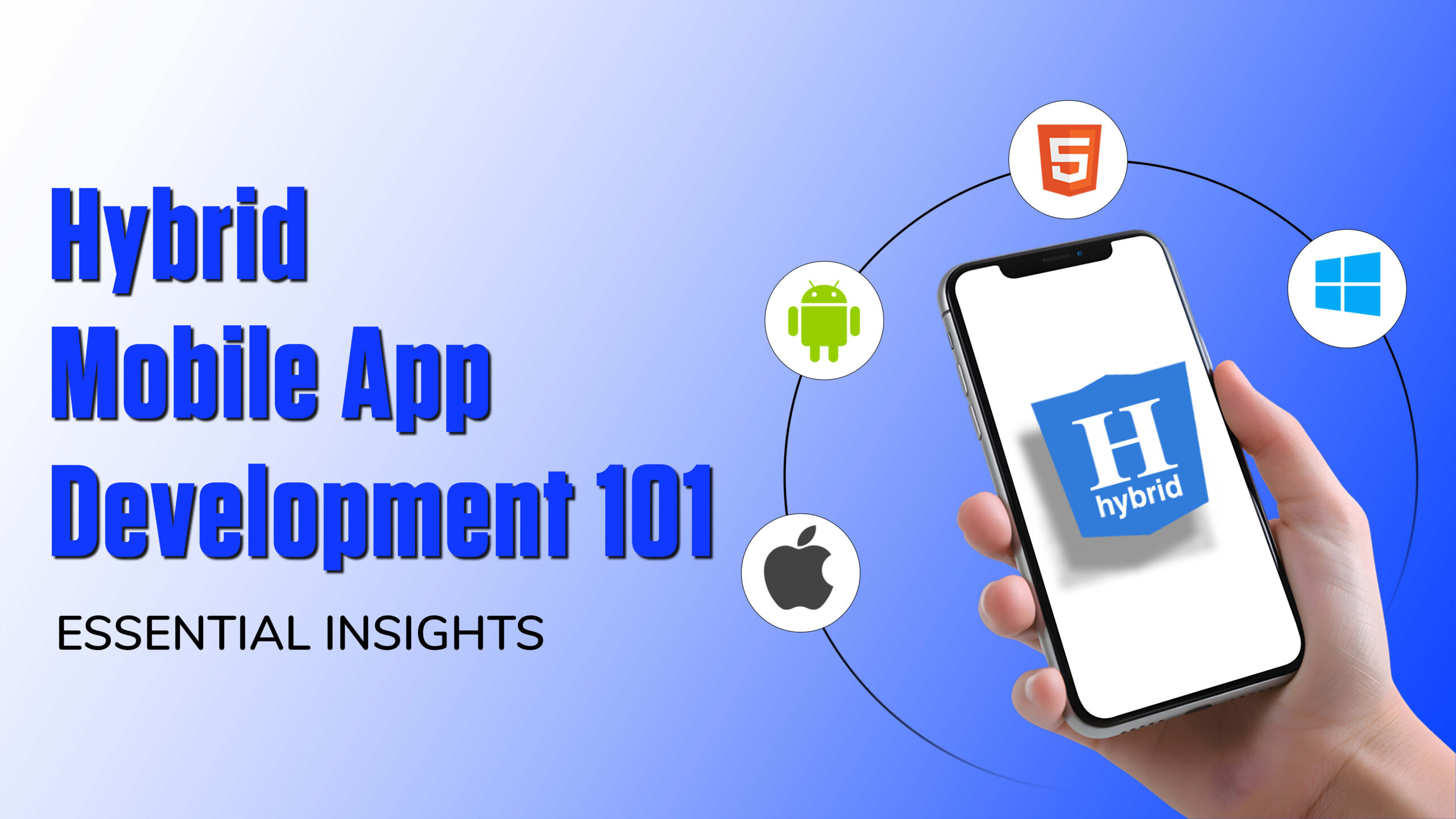The need for highly responsive and lightweight mobile applications has skyrocketed significantly in this ever-changing technical landscape. It paved the way for innovative and creative thinking, laying the cornerstone for what we know as hybrid applications. Running on a single codebase, the software is responsive and functional regardless of the mobile’s operating system. In other words, a single application can easily function on Android and iOS without compromising its speed, loading time, or feature accessibility. Given the need for mobile apps in marketing and customer acquisition, businesses should start investing in hybrid mobile app development for their brand.
However, following the same path as that of native app development won’t bring any success to the project. Rather, you need to understand the ins and outs of developing a hybrid mobile app, including its benefits for your business, features, development cycle, and technology stack to be used. With this being said, we have prepared a detailed guide, explaining hybrid app development in detail so that you can have a transparent picture of the project and draw an accurate scope.
Introducing Hybrid Mobile Applications: How Are They Different From Native Apps?
Before discussing anything about the development process or its advantages and challenges, let’s first understand what hybrid mobile applications are and how they differ from native apps. Usually, a regular mobile application is developed for a specific operating system, like Android or iOS. As a result, if you try to run them on another OS, it won’t be possible due to configuration issues and compatibility factors. To design a native application for both iOS and Android, you will need two different codebases concerning the different platforms.
However, when we talk about a hybrid mobile application, it comprises a single codebase that is developed to be compatible with both iOS and Android. No special change needs to be made to the architecture to support the application on a different platform. As a result, it offers more flexibility to the developers since they have to work on a single codebase and deploy the same across multiple platforms without any hassle. A hybrid mobile app development project has much lower costs and timelines, which further ensures a faster time to market and better development results.
Key Features and Benefits of Hybrid Application Development
Cost-effectiveness
Whenever we are talking about a software development project, cost plays a significant role in determining its success rate and feasibility. If you are planning to launch a mobile application responsive for multiple platforms, a native development project will incur humongous costs. So, choosing the hybrid development project seems to be a much more feasible option since it can:
- Reduce the development and project costs by allowing professionals to work on a single codebase
- Reduce the need for having multiple employees on your team, each having expertise in Android and iOS development
Faster Time to Market
Since hybrid applications require a single codebase for functioning across multiple platforms, you won’t have to dedicate weeks to developing different versions of the underlying technical architecture. It will significantly reduce the time consumed in developing the software, ensuring a faster time to market. In other words, you can deploy the hybrid app faster for your end users due to the eliminated dependencies on multiple code versions and the difficulties of working with different frameworks.
Cross-platform Compatibility
One of the major advantages of hybrid mobile app development is the software’s cross-platform compatibility. It can be deployed across multiple platforms or operating systems, like iOS and Android. There is no need to rewrite the codes specific to a single platform or work on the entire underlying technical architecture from scratch. Besides, there won’t be any compromise with the application’s features or accessibility, regardless of the platforms they will be deployed to.
Access to Device Features
The development team can utilize several plugins from third-party sources or custom development to ensure the hybrid mobile apps can access the native device features. For example, a hybrid mobile payment software with an additional plugin can access the cameras of both Android and iOS devices without any hassle. Similarly, an e-commerce application with a hybrid architecture will be compatible with the built-in voice assistants of both devices.
Easier Maintenance
When you start a hybrid mobile app development project, it’s not just about creating and deploying the software across multiple platforms. Rather, you do need to consider the long-term impacts, like maintenance ease of the software or deployment of security fixes. Since the hybrid mobile application runs on a single codebase, any data or security patch that needs to be provided can be done in a unified manner. There won’t be any need to develop different patches or fixes specific to the platform where they need to be deployed. Additionally, both Android and iOS users will have easy and unhindered access to the latest versions of the application with all the patches and upgrades.
Improved User Experience
One of the significant benefits of hybrid mobile app development is enhanced user experience. Firstly, developers can easily design a consistent UI with microservice-based technical architecture. It will provide a seamless user experience across all devices, regardless of the operating system and the screen size. Additionally, hybrid applications can use the cache memory to make certain features available for use even when the internet connection is not active.
Scalability and Flexibility
Last but not least, hybrid applications are highly scalable, owing to which developers won’t have to rewrite the entire codebase from scratch while developing a new feature or modifying an existing workflow. It not only reduces time complexities but also ensures extra effort can be eliminated from the picture.
Challenges with Developing Hybrid Mobile Apps
Slowed Performance
One of the major challenges that developers can encounter with the hybrid app is its slowed performance. Since the codebase will be quite complicated, the application will have slowed performance. On top of this, if we are talking about extensive applications, like gaming software, there will be significant lags in response generations due to code complexity and resource utilization.
Limited Native Feature Accessibility
Although third-party plugins can be used to ensure the hybrid application accesses the device’s native features, it isn’t the same as that of the native application. In other words, the number of device features that can be accessed through the plugins will be extremely limited, and it might often create problems with the app’s loading time and speed.
Dependency on Third-party Frameworks
Another challenge that you will encounter with hybrid mobile app development is too much dependency on third-party frameworks like Flutter, Ionic, and React. If there are changes in the framework’s version, your application might take a hit and can suffer from outage or inaccessibility. Besides, relying too much on third-party frameworks can introduce inconsistencies in software performance and user experience.
Security Concerns
Also, there will be security and privacy concerns with a hybrid mobile application, which, if not addressed from the beginning, can make the software vulnerable to external threats and cyberattacks.
Development Lifecycle for Hybrid Mobile Applications
Now that we have discussed the benefits and challenges of hybrid mobile app development, it’s time to have a look at the entire development life cycle, segregated into the major phases. It will help you understand the workflow and plan the entire project with ease.
1. Requirement gathering and scope planning: The very first stage of the development project will be to gather the requirements in detail, including both business and technical needs. For example, the types of target audience you want to reach through the hybrid application, your overall budget, the existing technical architecture, and so on. It will further help in accurate planning of the project’s scope and designing of the development roadmap.
2. Architecture designing: After analyzing all the business requirements, professionals will design a comprehensive and responsive product architecture. It can be considered the wireframe of the software’s UI and the backend layers, like defining the interactive services between the backend and frontend layers, establishing JDBC connections, and many more.
3. Development: This is perhaps the most complex and difficult phase where developers will write a huge codebase, catering to the project’s plan and implementing the features you expect in the hybrid application. In most projects, a microservice-based approach is considered where each functionality or feature will be handled by a separate module. These modules interact with one another using service-based APIs, thereby reducing dependencies and impacts.
4. Testing: Once the software development is complete, it will be subjected to multiple rounds of thorough testing. Usually, a series of testing approaches are adopted, like system integration testing, user acceptance testing, functional testing, and load and volume testing. This ensures quick and easy detection of any discrepancy or underlying bug and allows developers to bridge the performance gap with ease.
5. Deployment: Based on the success of the testing phase, the deployment schedule will be decided. Usually, DevOps principles are adopted to ensure continuous and automated deployment of the hybrid application across multiple platforms, like Android and iOS.
Conclusion
In this article, we have explained the basics of hybrid mobile app development that you need to know before embarking on the project. Since it is quite advanced and requires in-depth knowledge about different frameworks like Flutter and Ionic, knowing the software itself and its capabilities or limitations will play a huge role in project planning and progress. You can rest assured that with professionals like Web 3.0 India, your dream of a hybrid mobile application will come to life without any compromise with software performance, quality, and user experience.





